 Introduction to Byzantine coins (491-1453)
Introduction to Byzantine coins (491-1453)  Introduction to Byzantine coins (491-1453)
Introduction to Byzantine coins (491-1453)
In the fourth century the Roman empire encompassed the entire region around the Mediterranean Sea. When the western half fell in the fifth century, the eastern half lived on for a thousand years until 1453 as the "Byzantine Empire," with its capital at Constantinople (modern Istanbul). (This site has links to off-site maps so you can see the extent of the empire at various times.) Coins of the early Byzantine empire were gold, silver, or copper.
Coin to the upper right: A common copper coin of Justinian (527-565), struck 529-531. The large "M" (M = 40 in Greek) on the reverse indicates the denomination, 40 nummi, which we call a "follis." It is large, as large as a US half-dollar. 31-28 mm. 13.52 grams.
Obverse: Profile bust of Justinian with his name and titles around:
DN IVSTINI-ANVS PP AVG
Reverse: Large M with stars and a cross and the mint mark "+THЄUP+" (Small o above the P) in exergue, for "Theoupolis", the name the city of Antioch was using at the time, with Δ (Delta) for the fourth (Δ = 4 in Greek) officina (mint workshop).
Sear 216 (The primary identification reference for Byzantine coins is Byzantine Coins and Their Values by David Sear. Each coin on this site is identified by its Sear number. Reference works are discussed on this page.)
What's new? 2024, August 23: On page 3, coins of the rare emperors Philippicus and Anastasius II, successors of Justinian II.
2023, May 24: A coin of the usuper Isaac Comnenus in Cyprus.
2023, March 15: Revolt of the Heraclii (608-610).
2023: Coins added and image-sizes increased on page 3, "Byzantine emperors on coins."
2022, Sept. 27: The name of Heraclius (610-641).
Contents:
This page: Two large photos of many coins that represent the whole series, followed by an outline of Byzantine coins with examples.
Gold coins. Silver coins. Common copper coins, their dates, and their denominations.
Coins under the later empire and cup-shaped coins. After 1204 when Constantinople was conquered by the crusaders of the Fourth Crusade.
Common mints. Overstrikes and dating. Some terminology (a glossary) used to describe Byzantine coins.
Page 2: Byzantine-Coin Letters, Numerals, Denominations, Mints, and Dates Page 2A: A few obscure mints.
Page 3: Byzantine Emperors on Coins, 491-c.1118. Maps for every 100 years.
Byzantine "anonymous folles" of the 10th-11th centuries (on their own pages).
Page 4: Late Byzantine AE, 1059-1204 (Constantine X until the fall of Constantinople to the crusaders).
Page 5: Byzantine Coins, 1204-1453.
Page 6: Legends on Byzantine coins. How to read Byzantine coins.
Page 7: Reference works, annotated.
A related page: Under Justinian the mint of Antoch employed many different mintmarks. Here's the story.
Stories of particular rulers: The name of Heraclius (610-641). A short page on the empress Irene (780-802). The story of Basil I (867-886). The story of Constantine VII (913-959). On the coin reform of Alexius I (1081-1118). A short page on the usurper Isaac Comnenus (1185-1191). A coin of Heraclius from the Cyprus mint.
The first two large photos survey the field.
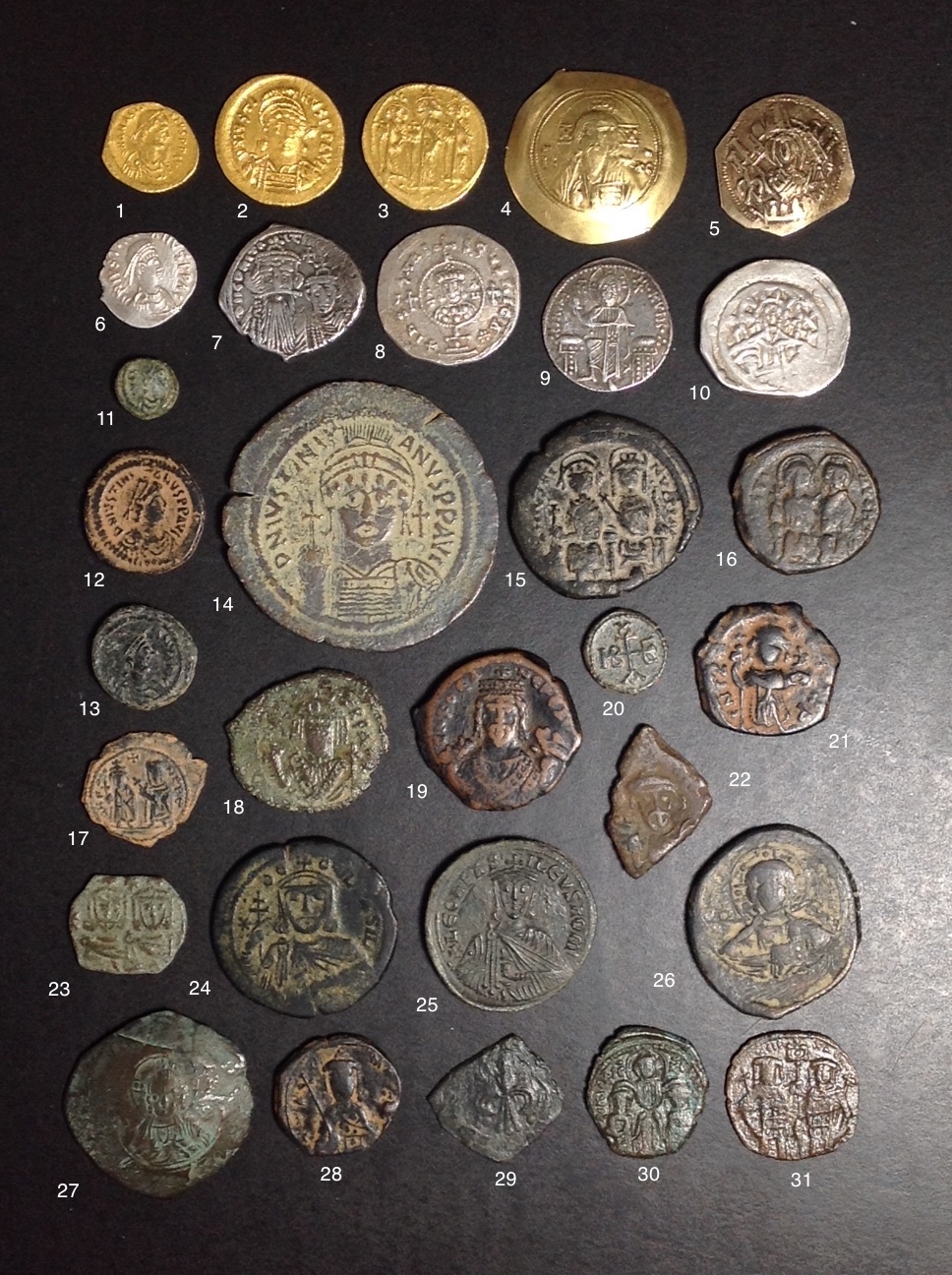 Top row: Byzantine gold coins:
Top row: Byzantine gold coins:
1) Anastasius (491-518) tremissis (1/3 solidus),
2) Justin (518-527) solidus,
3) Heraclius (610-641) solidus
4) (cup-shaped) Michael VII (1071-1078) histamenon,
5) Andronicus II (1325-1328) hyperpyron with city walls (clipped)
Second row: Byzantine silver coins:
6) Justinian (527-565) half-siliqua
7) Constans II (641-668) hexagram
8) John I (970-976) miliaresion.
9) Andronicus II and Michael VIII (1294-1320) basilikon with Christ seated
10) John VIII (1423-1448) stavraton [crude]
Third row (with the very big coin). Copper and base metal coins: First, four Justinian coins:
11) Justinian (527-565) 1-nummus.
12) 5-nummus, with Є = 5 on the reverse.
13) 10-nummus, with I = 10 on the reverse.
14) Very large 40-nummus "follis" with a large M = 40 on the reverse.
15) Justin II and Sophia (565-578) 40-nummus follis.
16) Justin II and Sophia 20-nummus half-follis with K = 20 on the reverse.
Row 4:
17) Phocas and Leontia (602-610) 10-nummus, with X on the reverse.
18) Phocas, 20-nummus. XX on the reverse.
19) Phocas, 40-nummus follis.
20) Phocas, 5-nummus monogram, with Є = 5 on the reverse.
21) Constans II (641-668) follis.
22) Justinian II (685-695), 20-nummus struck on flan which was one quarter of a large follis.
Row 5:
23) Constantine V (741-775) follis.
24) Theophilus (829-842) follis.
25) Leo VI (886-912) follis.
26) anonymous follis of c. 1034-1041 with bust of Christ.
Row 6 (bottom row):
27) Manuel I (1143-1180) cup-shaped trachy.
28) Alexius I (1081-1118) tetarteron.
29) Theodore II of the Empire of Nicaea (1254-1258) tetarteron.
30) Andronicus II and Michael IX (1295-1320) (with Christ as the third figure) assarion.
31) Androncius II and Michael IX (1295-1320) assarion.
 Top row: Byzantine gold coins:
Top row: Byzantine gold coins:
1) Anastasius (491-518) tremissis = 1/3 solidus.
2) Justin (518-527) solidus.
3) Heraclius (610-641) solidus.
4) Michael VII (1071-1078) histamenon (cup-shaped).
5) Andronicus II (1325-1328) hyperpyron (clipped).
Second row: Byzantine silver coins:
6) Justinian (527-565) half-siliqua.
7) Constans II (641-668) hexagram.
8) John I (970-976) miliaresion {5-line legend}.
9) Andronicus II and Michael VIII (1294-1320) basilikon.
10) John VIII (1423-1448) stavraton.
Third row. Copper and base metal coins: (First, three coins down the left): Four coins of Justinian, 527-565).
11) 1-nummus, with Christian chi-rho.
12) 5-nummus with Є = 5.
13) 10-nummus with I = 10.
14) 40-nummus "follis" with M = 40 struck year 13 (XIII) at Nicomedia (NIK).
15) Justin II and Sophia (565-578), 40-nummus follis with M.
16) Justin II and Sophia (565-578), 20-nummus half-follis with K.
Row 4:
17) Phocas and Leontia (602-610), 10-nummus, with X = 10.
18) Phocas, 20-nummus with XX.
19) Phocas, 40-nummus with cursive m.
20) Phocas, 5-nummus with Є+.
21) Constans II (641-668) follis with a cursive m = 40.
22) Justinian II (685-695) 20-nummus with K on flan made from one-quarter of a large follis.
Row 5 (second row from the bottom):
23) Constantine V (741-775) follis.
24) Theophilus (829-842) follis with M = 40.
25) Leo VI (886-912) with a 4-line legend. Follis.
26) anonymous follis (c. 1034-1041) with a cross and 3-line legend.
Row 6 (bottom row):
27) Manuel I (1143-1180) trachy, cup-shaped.
28) Alexius I (1081-1118) tetarteron.
29) Theodore II of the Empire of Nicaea (1254-1258) tetarteron.
30) Andronicus II and Michael IX (1295-1320) with a winged angel, assarion
31) Androncius II and Michael IX (1295-1320) with a Palaeologid monogram, assarion.
Note: Most of the above coins will be discussed individually below.
Gold coins are common. Silver coins are scarce or rare. Copper coins are common, inexpensive, and discussed extensively below.
Gold Coins. Gold coins are plentiful and often available in excellent condition.
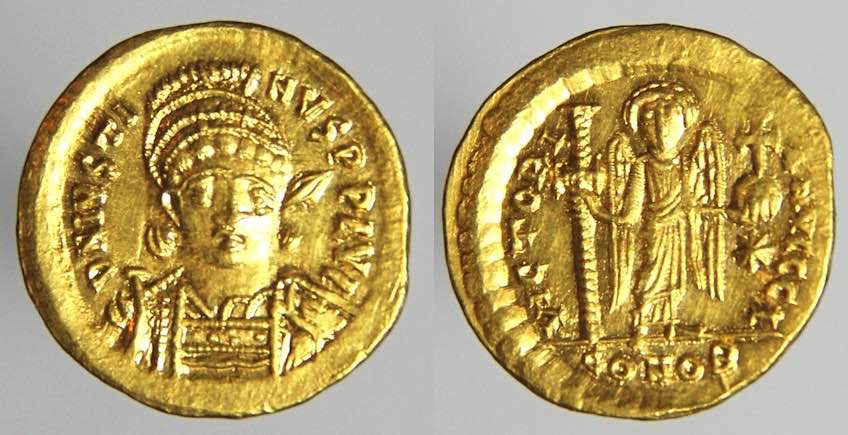 A gold solidus of Justin I (518-527), the second Byzantine emperor.
A gold solidus of Justin I (518-527), the second Byzantine emperor.
Nearly pure gold. 20 mm. (Slightly larger than a US cent.) 4.47 grams.
The obverse gives his name: DN IVSTINVS PP AVG
VICTORIA AVGGGI, an angel holding a long cross and cross on globe (globus cruciger)
This denomination was maintained at this size and weight for hundreds of years.
Sear 56
Some collectors concentrate on gold coins. They are often in high grade and cost hundreds or thousands of dollars. Most auctions by major firms have Byzantine gold coins.
Sizes. Ancient coin sizes are given in millimeters (mm) and weights in grams. For reference, a new nickel is 21 mm and weighs 5.00 grams. A US dime is 18 mm, a cent is 19 mm, a quarter 24 mm, a half-dollar 30.4 mm, and a silver dollar 38 mm. This is important to know because images do not tell you the sizes of the coins. It is easy to mistake a small coin for a large one. When buying an ancient coin, be sure to check the size which will be given in millimeters.
Gold coins under the early empire come in three denominations--the solidus (above) and its half, the semissis (not illustrated here), and its third, the tremissis (next).
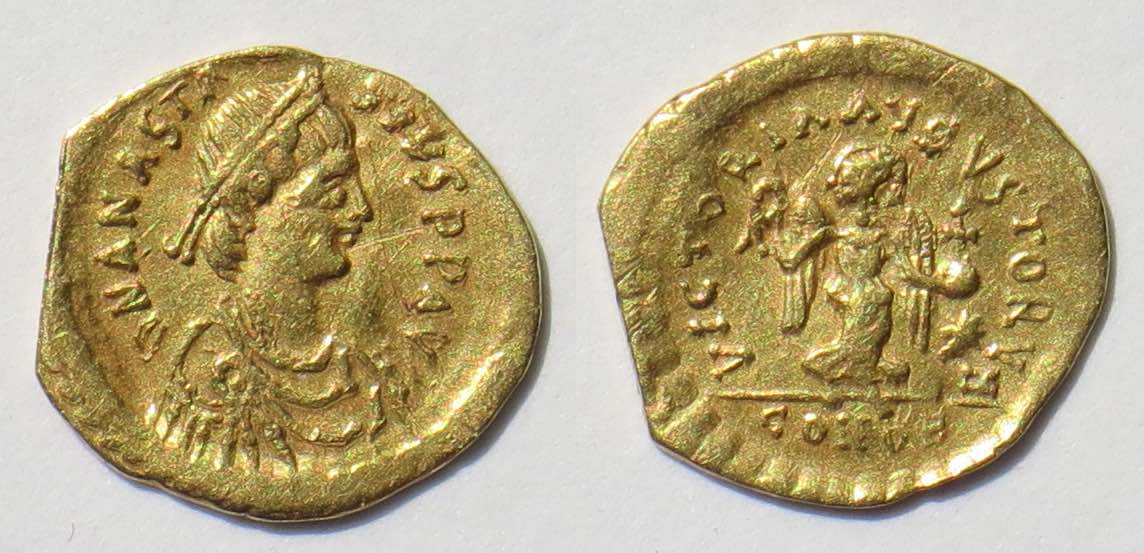
A tremisis of Anastasius (491-518).
15-14 mm. 1.36 grams (a little lighter than the desired one-third of 4.45 = 1.48 grams because a bit of gold has been shaved off from 8:00 to 10:00). Tremisses are thin, easy to clip, and often somewhat wrinkled or bent.
VICTORIA AVSVSTORVM (with two letters not well-formed. An "S" shape is for "G".)
Victory standing left holding wreath and globe with cross (called a "globus cruciger").
CONOB in exergue.
Sear 10.
Silver Coins. Under the Roman empire silver coins are common and commonly collected. Not so for Byzantine silver. Byzantine silver is not common except for the 8th-10th centuries and a few other emperors. Many collectors focus on gold and many on copper, but not many focus on silver (although some do).
The first Byzantine silver coins are small, thin, and rare. They were issued as fractions of the late Roman silver "siliqua" denomination. In the east, sixth-century silver primarily formed a ceremonial function, unlike in the western provinces, such as Italy and North Africa, where more substantial fractional silver issues continued the tradition in use under the Germanic kingdoms prior to their conquest under Justinian. Heraclius (610-641) introduced a new silver denomination, the hexagram, thicker and heavier with a substantial amount of silver.
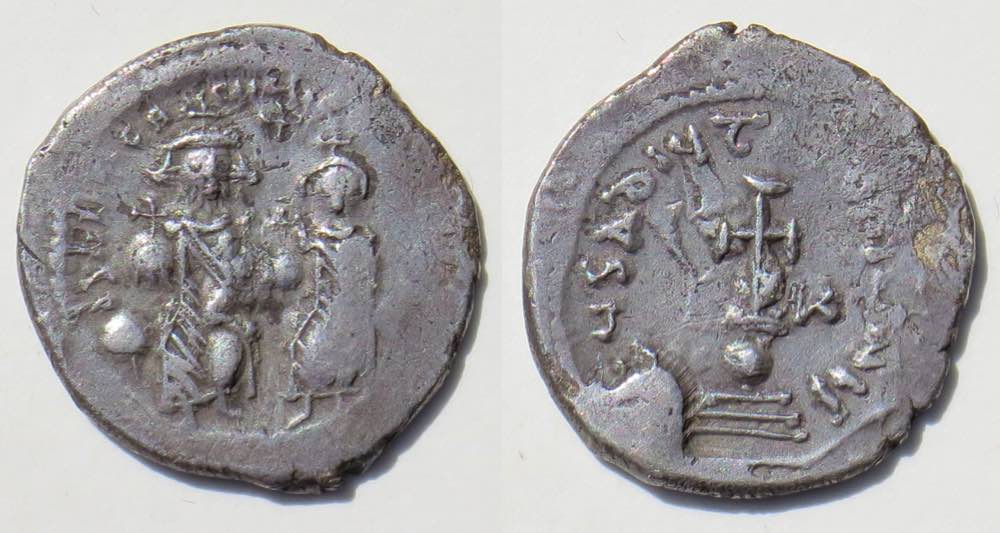 Heraclius (610-641) and his son Heraclius Constantine.
Heraclius (610-641) and his son Heraclius Constantine.
Silver hexagram. 23 mm. 6.71 grams. Thick.
Emperors seated on a double throne, each holding a globus cruciger in his right hand
Cross on globe on three steps.
Hexagrams were introduced in 615 and continued to be issued in significant numbers until c. 680 under Constantine IV (668-685). They had good silver, but dies are usually poorly engraved and the strikes are usually bad. For example, this coin shows irregular lettering, a big die-break at 7:00 on the reverse, and a weak strike in several places. Nevertheless, it is in average condition.
Sear 798

Leo V and Constantine, 813-820
Silver miliaresion. 24 mm. 2.11 grams. Thin.
One-third the weight and a larger diameter than the above hexagram makes it much thinner.
Cross on three steps
5-line legend in Greek, "Leo and Constantine, by the grace of God, kings of the Romans."
Sear 1628
John I, Tzimses, 969-976.
Silver miliaresion. 23-22 mm. Thin. 2.92 grams
His name, John, is in the inner circle with the small facing bust
I A
ω N
The reverse says, in Greek, "John [IωAҺ], by the grace of Christ, autocrator and King of the Romans"
A silver "miliaresion". This denomination was introduced to compete with the Arab dirhem.
Sear 1792.
Hundreds of years later, near the very end of the empire when times were desperate, silver was confiscated from churches and anywhere else it could be found and chunky silver coins were issued to pay debts. For the last few emperors before the fall of the empire in 1453 silver was the usual metal for coins (but they are not common, except for issues under John VIII).
Copper Coins. Byzantine copper is common, inexpensive, and easy to collect. However, they are usually poorly produced and very worn. Ancient-coin collectors who love the artistry of Greek coins or the expressive portraits on Roman coins will find nothing comparable on Byzantine coins. It is difficult to find Byzantine copper with a clear bust of the emperor and a full legible legend. But, if you like history, Byzantine copper has great stories to tell. (Here is one about Constantine VII, 919-957. Here is another about the mint of Antioch after massive earthquakes. You can read those later; there will be links to them again later.)
When Did The Byzantine Empire Begin? The date when the "Byzantine" empire began is debated by historians, but from the point-of-view of numismatists it begins with the reign of Anastasius (491-518). (For the reasons for this choice, see my page here.) .
Byzantine Coins. Byzantine coins begin under Anastasius, 491-518, who reformed the copper coinage in 498 by adding in a range of higher denominations. The copper coinage he inherited consisted of only tiny and poorly made pieces of the "1-nummus" denomination. (The illustrations on this page are to scale. Enlargements are noted.)
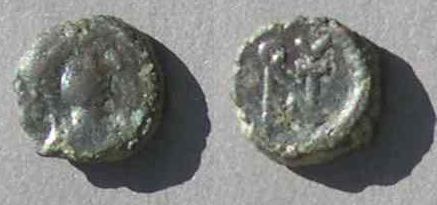
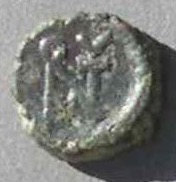 The pre-reform nummus of Anastasius, emperor 491-518 with its reverse monogram enlarged. The obverse has a profile bust right, but the coins are too small to have any distinguishing obverse legend. The reverse is a monogram for Anastasius. The coins of this era are so terrible that this one is much better than average.
The pre-reform nummus of Anastasius, emperor 491-518 with its reverse monogram enlarged. The obverse has a profile bust right, but the coins are too small to have any distinguishing obverse legend. The reverse is a monogram for Anastasius. The coins of this era are so terrible that this one is much better than average.
8 mm. Tiny! 0.98 grams. Sear 13.
There was no larger copper denomination until the reform of Anastasius.
 A follis of the first reform of Anastasius. 25 mm. 3.58 grams.
A follis of the first reform of Anastasius. 25 mm. 3.58 grams.
This 25 mm coin is slightly larger than a US quarter (which is 24 mm). This is a much-improved coin. Some weigh as much as 8 grams.
Large M. Stars to the left and right of the M and a cross above. The delta (Δ) below is 4 in Greek and indicates the fourth workshop (officina) of the mint.
CON below is the mintmark of Constantinople.
Obverse legend: DN ANASTASIVS PP AVG (Dominus Noster [Our Lord] Anastasius PerPetuus [forever] AVGustus [emperor]).
Sear 16.
The follis denomination lasted 500 years. It had its ups and downs, getting larger and nicer with reforms and then smaller and worse and then larger and then smaller again, but it remains the primary copper-coin denomination.
You might notice that the improved coin supposedly worth 40 nummi is not nearly 40 times as heavy as the previous 1-gram 1-nummus coin. The Byzantine populace noted that too and were unhappy about it. Discontent led to a second reform c. 512 which increased the size and weight of the follis.
 [Not to scale with the other coins. This one is too large!]
[Not to scale with the other coins. This one is too large!]
Anastasius, 40-nummus. 35 mm.18.20 grams.
Note that a US 50-cent piece is only 30.6 mm and 11.34 grams. This follis is huge.
The second reform increased the weight of all the copper denominations. The follis is still not 40 times the weight of the nummus, but the large, impressive, new coins were accepted and became standard.
Sear 19.
To distinguish the two types of Anastasius with the same design the first-reform (25 mm) pieces are called "small module" and the second-reform (35 mm) pieces "large module."
In many ways the change from "Roman" to "Byzantine" was on a continuum. The fact that the dividing line is worth debating proves there is no obvious dividing line suitable for all purposes. However, for our purposes as numismatists, the emperor Anastasius is the first Byzantine emperor. He introduced the 40-nummus follis which is the most common denomination of Byzantine coins for 500 years.
Of course, when coins have metal value, the government can make more coins from the same amount of metal by making the coins smaller. This is an ancient equivalent of inflation. It is truly remarkable that the amount of gold in the gold coins did not decrease at all for centuries. However, the copper coins did, gradually, numerous times. Then reforms became necessary to restore a functioning coinage system.
Over the following decades the sizes of the denominations decreased gradually until the famous coin reform of Justinian in 538/9 again increased the sizes and introduced the facing-bust (instead of profile-bust) types (next).
Dating. Many Byzantine coins are dated only by the dates of the reign of the emperor. However, for many types scholars are able to give narrower date ranges. The greatest precision is found after the coin reform when Justinian added regnal-year dates to the copper coins which can then be dated to a single year. This followed an edict of his year 12 (538/9) which required official documents to be dated using regnal years. The occasion was used to reform the copper coinage by increasing its size and weight and changing the bust from profile to facing.
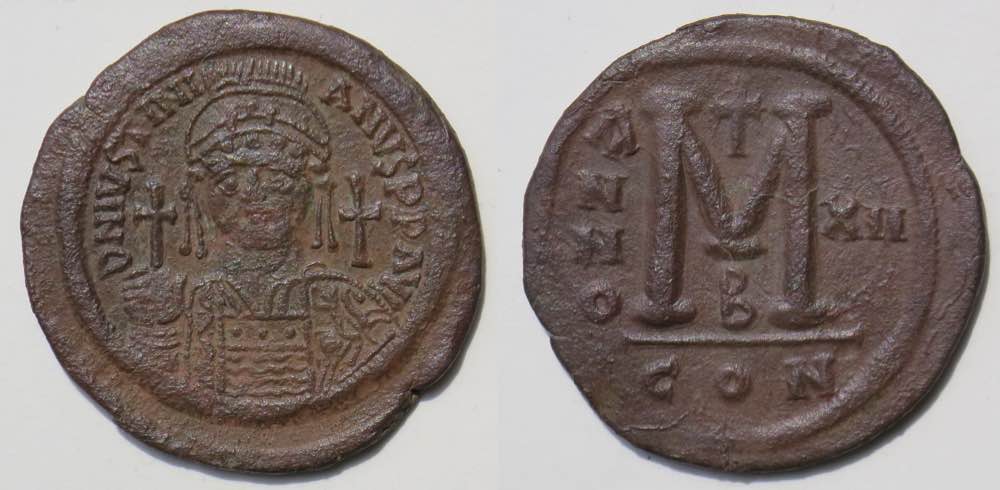 Justinian, 527-565.
Justinian, 527-565.
[Not to scale with the other coins. This one is too large!]
40 mm. 20.04 grams. A massive reformed follis. (A US half dollar is only 30.4 mm. This coin is so large the image here is made smaller in proportion to the others.)
The first year of issue, marked
ANNO for "year" and XII for "12" to the right of the M. Year 12 of Justinian was 538/9.
CON below is the mintmark for Constantinople.
This is perhaps the most desired Byzantine copper coin type because of its remarkable size. It is often well made and in good condition. Fortunately, it is quite common.
Years XIII and XIIII maintain the large size, after which the type continues but on smaller and smaller flans until it is only 30 mm (instead of 40 mm) at the end of his reign (year 39).
Byzantine coins continue to be dated by regnal years for about a hundred years. Also, they have officina numbers (Greek letters; the above coin has B for "2"). Collectors can, if they want, collect many varieties of what would be considered the same type (with only one Sear ID number) by collecting all its years and officina numbers. Sear's book lists them all.
(See a second page for more about dating and numerals.)
Denominations of Early Byzantine Copper. The 40-nummus piece, the follis, is by far the most common and commonly-collected denomination. For more than 300 years it is distinguished by its reverse with a large "M" for 40 in Greek (There are some, less common, that use Roman numerals instead). The early Byzantine copper denominations are the
follis (40-nummus) with M or XXXX
three-quarter follis (30-nummus) with Λ or XXX (these are uncommon)
half-follis (20-nummus) with K or XX
quarter-follis (10-nummus) with I or X
5-nummus (pentanummium) with Є or V.
Rare 1-nummus pieces continued to be issued through Maurice (582-602). Usually they are just tiny and without a denomination numeral.
There are other unusual denominations at some mints, but they are a much smaller part of the coinage and are discussed on page 2.
The Follis. The follis is the most common denomination, and most early folles have the large M (for 40) seen above. A few have "40" in Roman numerals: "XXXX" (never "XL" like modern Roman numerals). Most of them were for Phocas (602-610).
 Phocas, 602-610. (Coins spell his name "FOCAS".)
Phocas, 602-610. (Coins spell his name "FOCAS".)
35-32 mm. 11.65 grams.
DN FOCAS PERP AVG
Facing bust holding mappa in right and globus cruciger in left
ANNO (year)
XXXX with G for year 6 to the right
KYZA for Cyzicus (Kyzikos), officina A (= 1 in Greek) below.
Sear 665.
The 30-nummus denomination. 30-nummus pieces are not common. The Λ (30 in Greek) pieces are only of Heraclius's years 20 and 21 and in terrible condition (see the next page). The XXX (30 in Roman numerals) pieces are uncommon and almost all are of Tiberius II (578-582) and some are of Phocas (602-610).
 XXX for 30-nummus.
XXX for 30-nummus.
33 mm. 11.73 grams.
Tiberius II Constantine, 578-582.
∂m TIB CONSTANT PP AVG (much is unclear, including the ∂m)
Mintmark CONΓ (for Constantinople, officina 3. No date.)
Sear 432
Byzantine-coin legends are often blundered and misspelled (not only in this era). Some coins of other emperors begin properly with "DN," but legends of Tiberius II begin with "∂m" where the ∂ is a D.
These XXX pieces are struck on large flans, almost as if they used 40-nummus flans anyway and just struck them with dies marked 30-nummus.
The Half-Follis. The half-follis is distinguished by a large K, which is 20 in Greek. They are common.
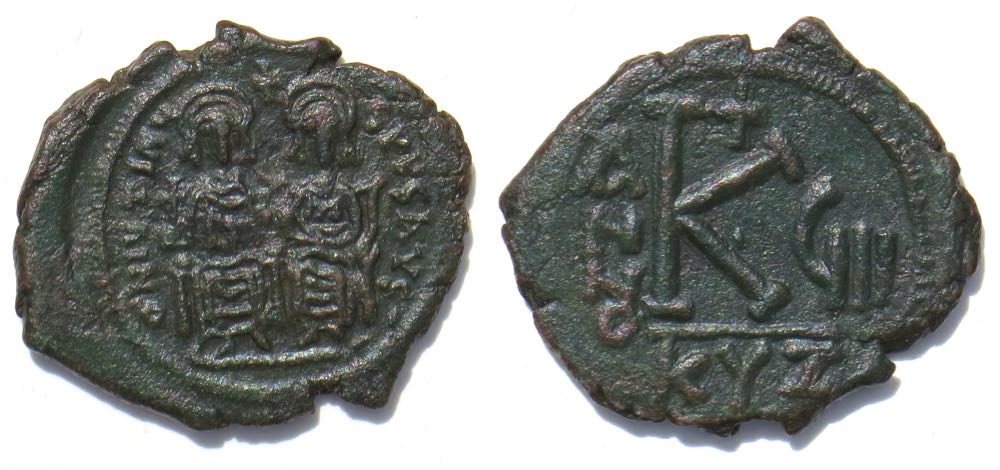 Justin II and Sophia, 565-578
Justin II and Sophia, 565-578A few half-folles have "XX" for "20" in Roman numerals.
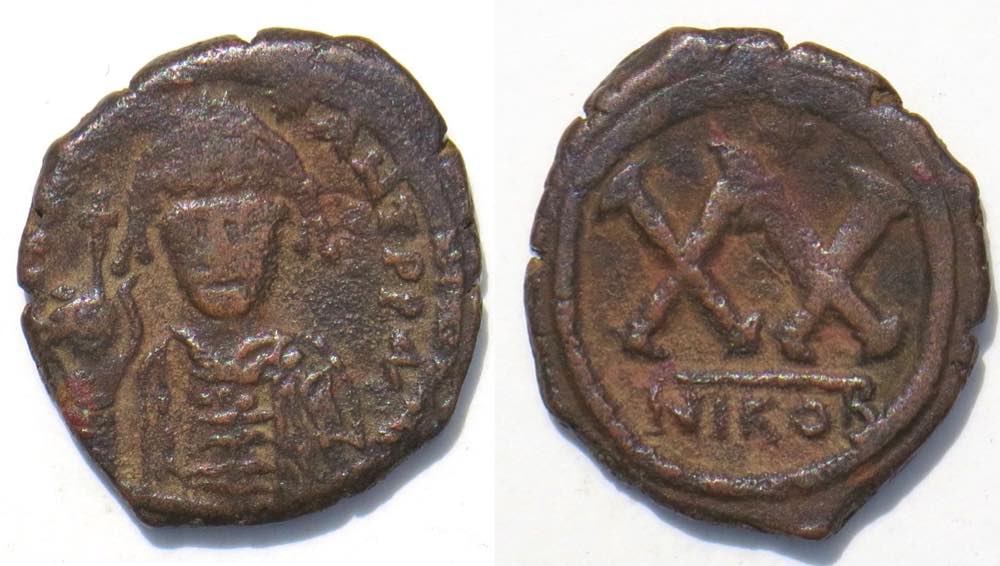 Tiberius II, 578-582.
Tiberius II, 578-582.
24-21 mm. 7.01 grams.
Half-follis. 20-nummus.
Bust facing, holding globus cruciger.
Large XX
NIKOB in exergue, for Nicomedia mint, officina B.
Sear 443. Nicomedia.
The quarter-follis. The quarter-follis is distinguished by a large I, which is 10 in Greek, or X, the Roman numeral. They are common.
 Justinian, 527-565.
Justinian, 527-565.
20-18 mm. 3.70 grams.
Quarter-follis. 10-nummus.
Bust right.
Large I surmounted by a cross. ANNO (for "year") down the left
XXG (for "26") down the right
A (for the first officina) below the I
CON in exergue, the mintmark of Constantinople.
Sear 168.
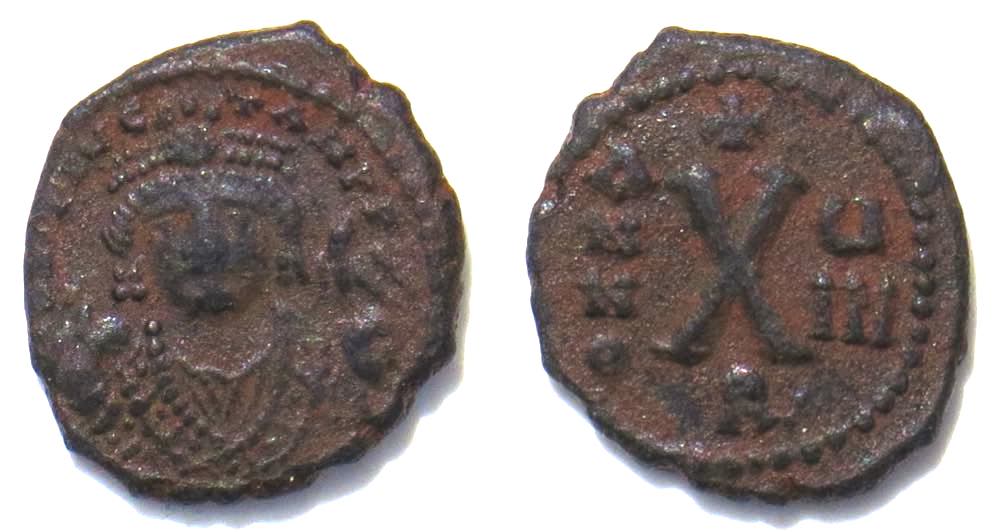 Maurice, 582-602
Maurice, 582-602
18-16 mm. 2.63 grams.
Quarter follis. 10-nummus.
Bust facing.
Large X, cross above, ANNO down left, U/III or year 8 down right
R below, a mintmark from Antioch.
Sear 536. Antioch.
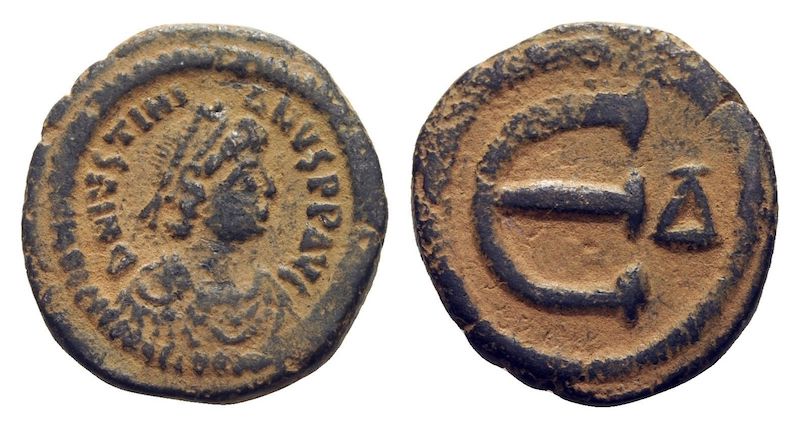
Not many 5-nummus pieces use Roman numerals, but some do.
 Tiberius II, 578-582
Tiberius II, 578-582
15 mm. 1.87 grams.
5-nummus.
Profile bust right
A u-like "V" for "5".
Sear 438. Constantinople.
 Justinian, 527-565, struck c. 547-552.
Justinian, 527-565, struck c. 547-552.
1-nummus. 9 mm. 1.23 grams.
Chi-Rho (XP, abbreviating CHRistus)
Minted at Carthage after Justinian recovered North Africa from the Vandals. Other mints did not issue this denomination. Sear 283.
Folles continue but omit the "M": In the ninth century folles begin to omit the M and have four lines of lettering instead. The last "K" and "I" pieces were struck under Constantine V (741-775) and the last coins with "M" under Michael II (820-829).
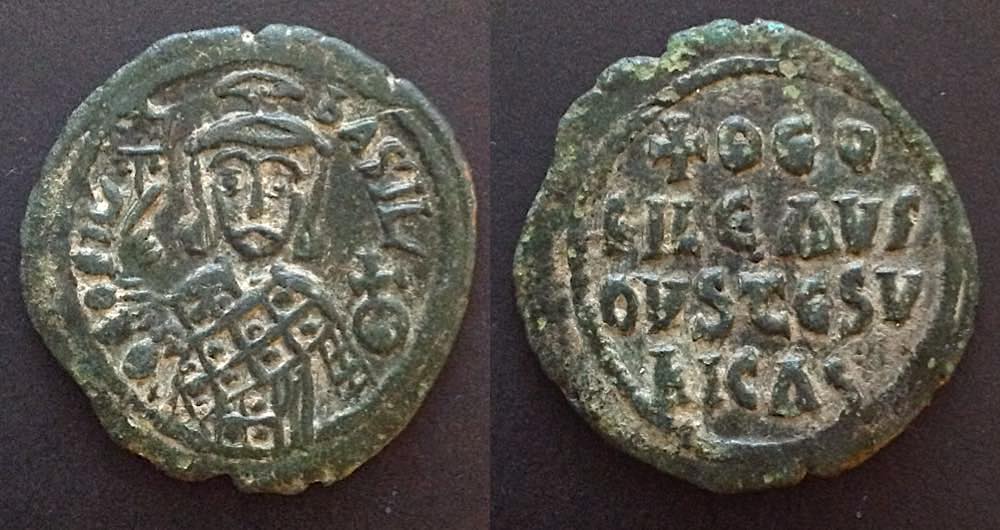 Theophilus, 829-842.
Theophilus, 829-842.
28 mm. 8.19 grams. Follis.
Emperor standing facing in elaborate robes (a loros)
holding standard in his right hand and a globus cruciger with his left hand
The reverse spells out "Theophilus, emperor, may you conquer"
+ΘЄΟ
FILЄ AVS
OVSTЄ SV
ҺICAS
Sear 1667.
(For many more copper coins of this and other time periods, see the page on Emperors on copper coins.)
At the end of the 10th century (in 970, under John I) folles became "anonymous" because they omitted the name of the emperor and replaced his portrait with a facing bust of Christ or Mary.
 An anonymous follis, minted during the reign of Basil II & Constantine VIII, 976-1028, and likely later as well. This type is known as "Class A2." The design lasted for over 50 years with the early ones being larger and the later ones smaller.
An anonymous follis, minted during the reign of Basil II & Constantine VIII, 976-1028, and likely later as well. This type is known as "Class A2." The design lasted for over 50 years with the early ones being larger and the later ones smaller.
Examples range from 35 mm down to 25 mm.
This one is larger than most at 32-30 mm and 12.75 grams.
Sear 1813, called "Class A2."
Obverse: Facing bust of Christ holding the gospels.
EMMA-NOVAHΛ around (Emmanuel), crosses on the gospels and in the quadrants of the nimbus (halo).
Reverse: A four-line legend:
+IhSUS (Jesus)
XRISTUS (Christ)
bASILЄU (King of
bASILЄ (kings)
For many more details about anonymous folles, see my page "Byzantine "anonymous folles" of the 10th-11th centuries."
Other Denominations. Many of the other denominations are illustrated on page 2 of this introduction. Most odd denominations are issued only at one mint and only for a short period of time. Alexandria (in Egypt) has 6-nummus, 12-nummus and even 33-nummus coins. Thessalonica has 2, 3, 4, 8, and 16-nummus coins. Cherson minted a few coins in multiples of 5 nummi, so their "8" ("H" in Greek) piece is the usual 40-nummus denomination (8x5 = 40) and their "4" (Δ in Greek) is the usual 20-nummus denomination. All of these are unusual, interesting, and desirable. They are discussed further on page 2.
The Later Empire. Alexius I (1081-1118) reformed the coins in 1092, introducing new denominations including concave "cup-shaped" coins in gold, silver, and billon. The reason for the cup shape has eluded scholars for centuries. (There are many scholarly articles on it. Here is a link to a recent one by Jonathan Jarrett.) Also, the proper name for this denomination has only recently been determined. Now they are called "trachy" (plural: trachea). "Trachy" refers to the cup-shape and originally meant "rough" or "uneven." The base-metal coins are "billon aspron trachy." "Billon" is a modern term for the alloy which is mostly copper and has a small, but significant, amount of silver. "Aspron" is the Byzantine term for low-silver coins. There are also trachy coins minted in gold, electrum (a gold and silver alloy), and silver. The shape used to be called "scyphate," a word which is still used but now known to be not the right one.
Here are four trachy coins pictured at an angle to show their curvature.
The flans are not round. Most are very poorly struck. Most have double strike slurring the design or even showing it twice with a die shift. Most have enough wear on the obverse (the convex part) to obscure its details, while the reverse is protected from wear by being inside the cup and maintains its original clarity, which is nevertheless usually far from clear.
The coins in the photo are thin, 25-29 mm, and 4-5 mm deep.
The next example is exceptional for quality.
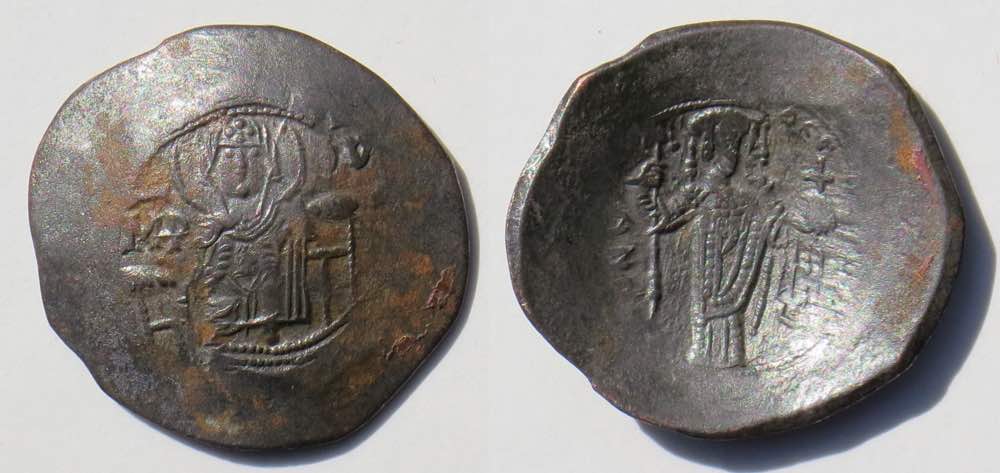
Manuel I, Comnenus, 1143-1180
29 mm. 5.34 grams.
Virgin enthroned, facing, MP ΘV (which abbreviates "Mother of God")
Manuel standing, holding labarum and globus cruciger.
Sear 1965.
Scholars have shown that these were struck at least twice, rocking the die to impress the left half and right half in two blows. Usually the two strikes do not line up correctly and the middle figure will show up twice, slightly alongside itself. Therefore, a coin of this clarity of design, especially on the obverse, is rare and worth a substantial premium.
Note for Collectors. Coins of this odd shape are common. Typical examples are inexpensive (less than $10) because the supply is large and the demand small. Because of their shape they are awkward for collectors to store. They are rarely attractive. And those which are regarded as "attractive" are really just attractive "for type." However, at least they connect to interesting history. Any example with full details on the obverse head and a good strike without slurred details is highly unusual and will command a large premium.
By the way, at the same time gold trachy were issued. The fineness is reduced from the pure gold of the early empire.
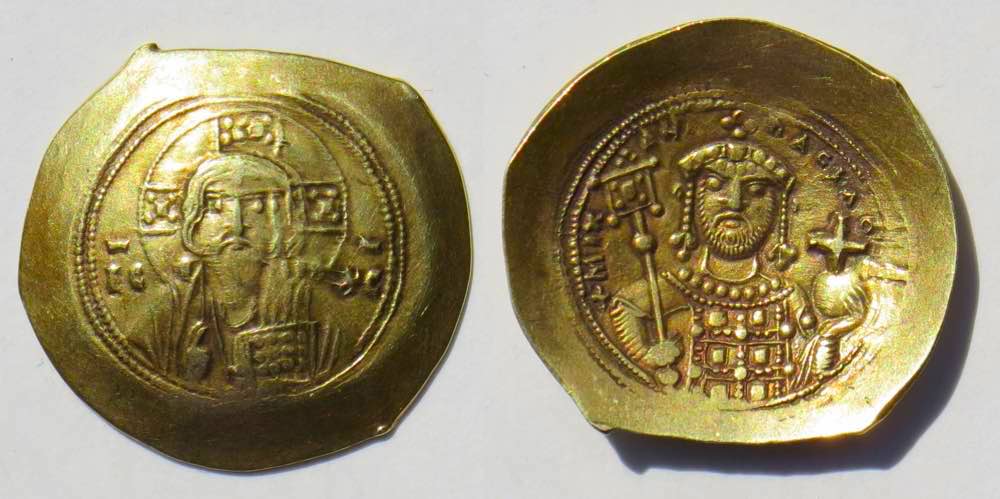 Michael VII, 1071-1078.
Michael VII, 1071-1078.
"Electrum histamenon nomisma." 28 mm. 4.24 grams.
(Electrum is the name for a gold and silver alloy.)
Bust of Christ facing.
Bust of Michael facing holding labarum and globus cruciger.
Sear 1868.
These coins, like the billon trachy, were usually struck twice. Often, the dies shifted a bit between strikes, On this example there is doubling on the right side (as we view it) of Christ's head. A piece without such blurring is worth a premium.
Late Copper Coins. When Alexius I reformed the coinage and introduced cup-shaped denominations, he also introduced a small flat copper "tetarteron" and its half.
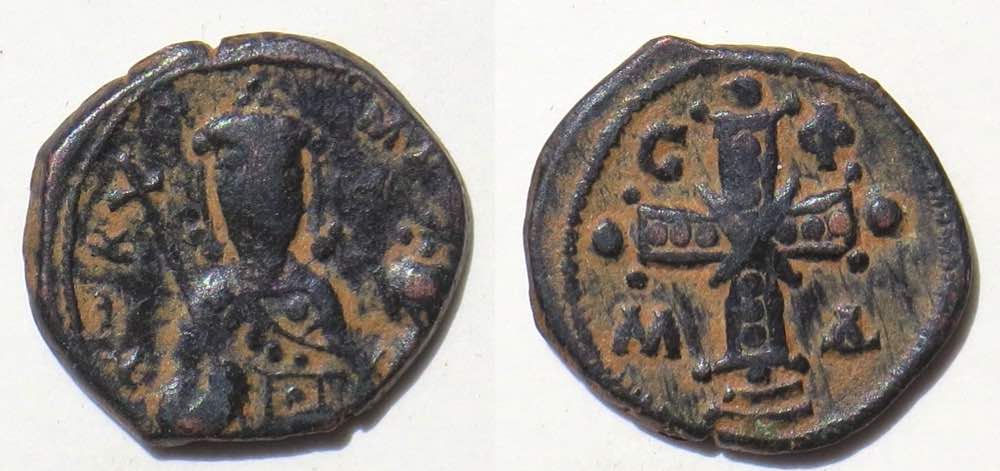
Alexius I, 1092-1118.
20-18 mm. 3.71 grams. Tetarteron.
Bust of the emperor facing, holding long cross in left and globus cruciger in right.
Jeweled square cross on steps, with C Φ ΑΛ Δ in its quadrants. The "A" in "ΑΛ" (For "Alexius") omits its crossbar so the pair look like an "M". The "Δ" is for "Despot" which means emperor. The C (a lunate S) and Φ abbreviate "Stavre phylatte", "Cross, protect".
Sear 1931
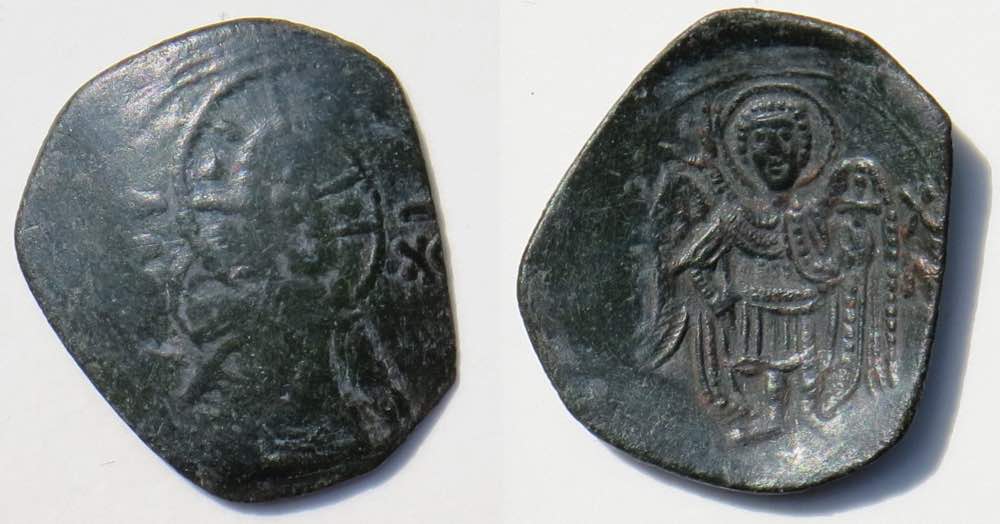
Latin rulers of Constantinople, 1204-1261
24-17 mm. 2.10 grams.
Bust of Christ
Archangel Michael, winged, with X to right.
Sear 2036
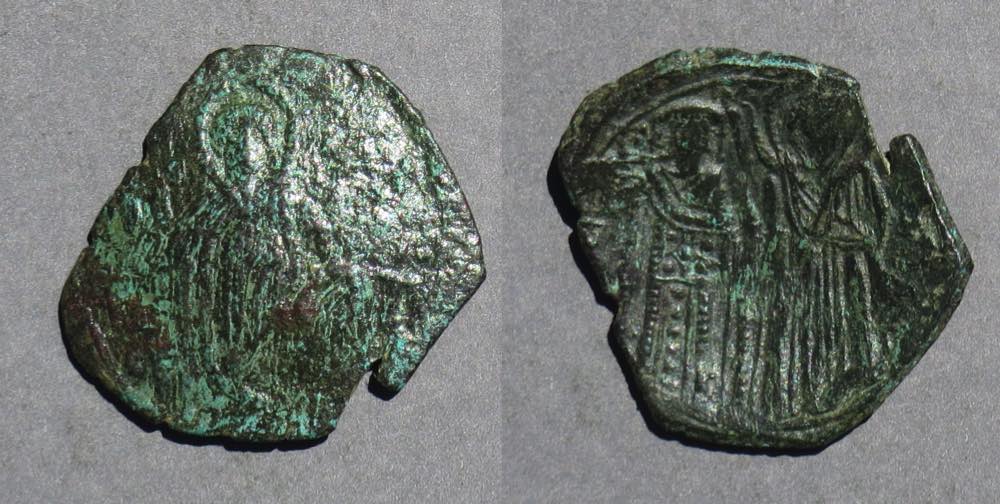
Michael VIII, 1261-1282.
25-21 mm. 2.60 grams. Slightly cup-shaped.
St. Demetrius standing.
Michael standing left being crowed by the Virgin.
Sear 2265.
The example, terrible as it is, is better than average.
Note for collectors. Coins of the restored empire are far more common than they used to be 30 years ago when Sear wrote his book. Many late Byzantine coins that were rare or very rare in the west circulated in regions that were behind the Iron Curtain until it fell in the 1990s. Then many late Byzantine coins were released to the market and some types have even become common. Therefore the valuations in Sear (published in 1987) of late Byzantine coins are sometimes much too high. On the other hand, there are very many types, unlike earlier centuries when an emperor would have only a few copper types for his whole reign. So, if you want a particular type it might take a very long time to find one. But, when you do, you will be competing with few other collectors.
The Last Emperors Minted Silver. Coins of the very last Byzantine emperor, Constantine XI, 1448-1453, were long expected from ancient written sources but the first did not appear on the market until 1974. Now only about 100 are known, all very expensive. However, silver coins of the immediately previous emperors are not so rare.
 John VIII, 1423-1448. The second-last emperor.
John VIII, 1423-1448. The second-last emperor.
24-22 mm. 6.73 grams. A "stavraton" = 1/2 hyperpyron.
Bust of Christ facing
Bust of emperor facing (His name would be in the flat region at 2:00).
Sear 2564.
This coin is quite crude with large areas of weakness in the strike. But, in the empire's final desperate straights the point was not to be artistic; it was to turn precious silver into coin.
This flatness is typical for these coins. One with John's name legible would command a premium.
Mints. Constantinople was the main Byzantine mint from the beginning all the way until the end of the empire. There were many other mints that issued coins for limited time periods. For example, coins of Nicomedia and Cyzicus are common from the sixth to eighth centuries even though both cities are close to Constantinople. (Nicomedia is 60 miles east and Cyzicus 80 miles southwest of Constantinope, both on the Asian side.) Most maps of Byzantine mints, including the wikipedia map under "Byzantine mints" https://en.wikipedia.org/wiki/Byzantine_mints
are correct but misleading, because many mints existed only for short periods of time and contributed almost nothing to Byzantine coinage.
The mints illustrated on this page include Constantinople, Nicomedia, Cyzicus, Antioch in Syria, Alexandria in Egypt, Carthage in North Africa, Syracuse in Sicily, and Cherson in Crimea. Other mints are less likely to be encountered [A few are discussed on a supplemental page here].
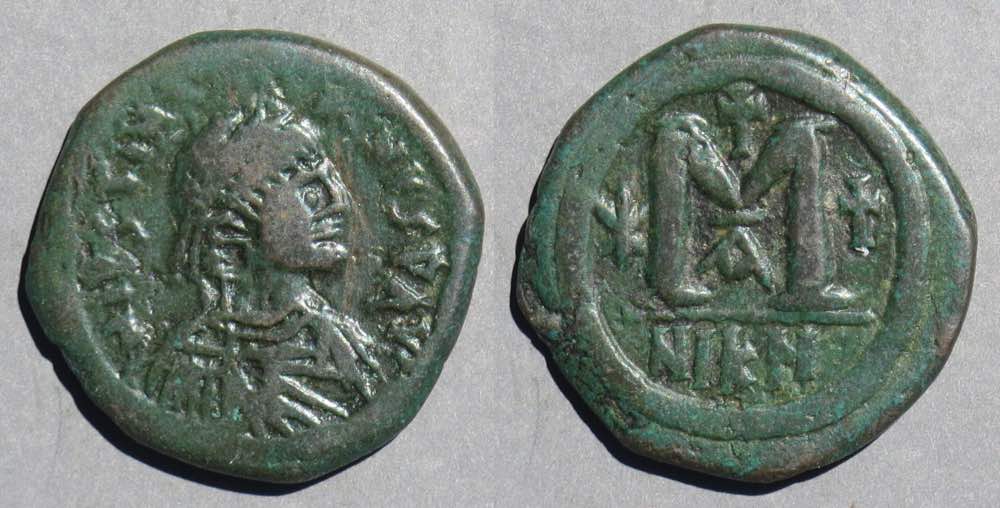
Justinian, 527-565
Follis. 29 mm. 16.20 grams.
NIKM for Nicomedia in exergue. Struck 527-538.
Sear 198.
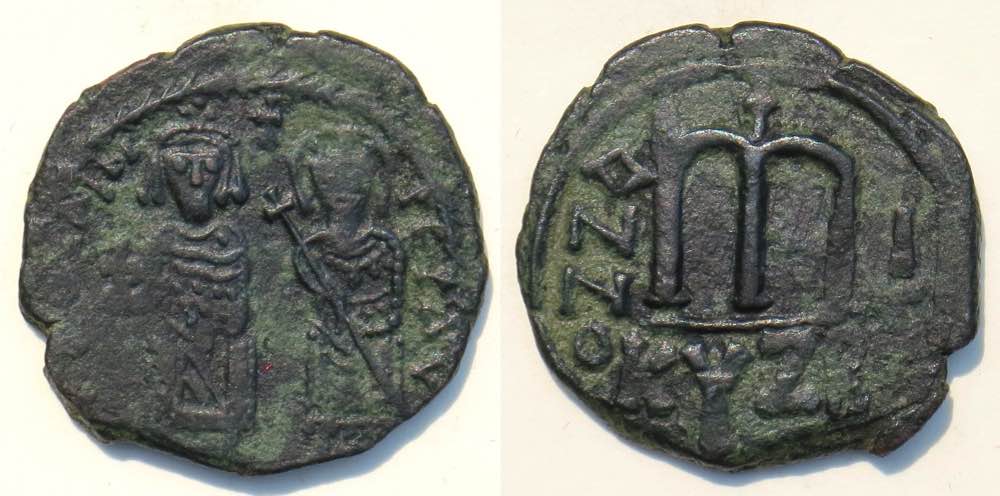
Phocas, 602-610.
29-28 mm. 11.88 grams. Follis
Phocas and empress Leontia.
KYZ, the mintmark of Cyzicus, in exergue.
Unusually, the m is cursive. ANNO (for "year") is down the left and "I" for year 1 on the right.
Sear 664.
Antioch. Antioch, in Syria near the northeast corner of the Mediterranean Sea, was one of the largest cities of the empire and a major mint until 637 when it was conquered by the Arabs.
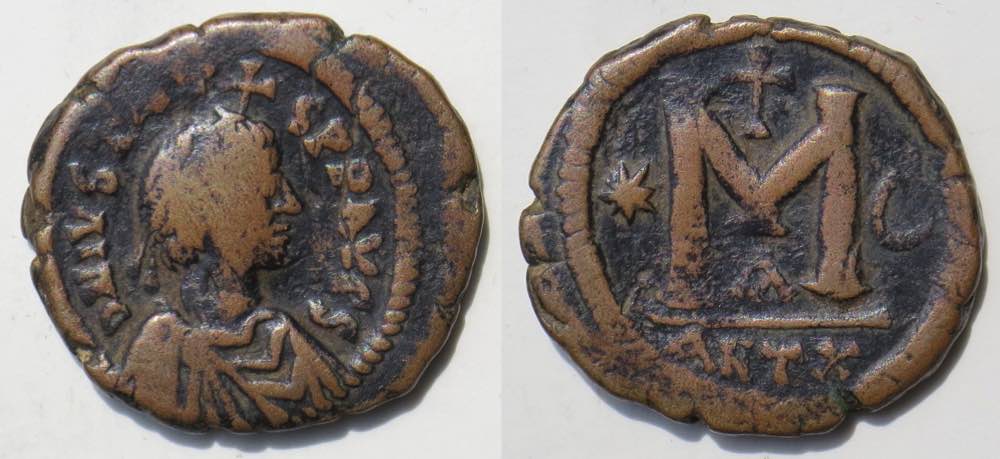 Justin I, 518-527.
Justin I, 518-527.
32-29 mm. 16.23 grams. Follis.
ANTX for Antioch, in exergue.
Sear 103.
At the end of the reign of Justin Antioch experienced a massive earthquake which destroyed most of the city and reportedly killed 250,000 people. The tragic story of subsequent events and their impact on the coinage of Antioch is told on my page here.
Above the obverse head on this particular coin is a cross, which is unusual. A friend of mine spent many years trying to discover the reason some coins had it but most don't. He never did find the reason. However, along the way he made the world's finest collection of cross-above-head Byzantine coins. Some were previously unknown varieties which have been passed along to major numismatic museums. You can see his collection here. (Most people would not have the idea that this could be a collecting theme, but it proves that you don't have to follow the crowd. Collect whatever you like.)
Other Significant Mints. Alexandria in Egypt was a Byzantine mint until it was conquered by the Arabs. For some unknown reason it employed denominations not used elsewhere, including "6", "12", and even "33." The "6" is scarce and the "33" rare, but the "12" denomination is common.
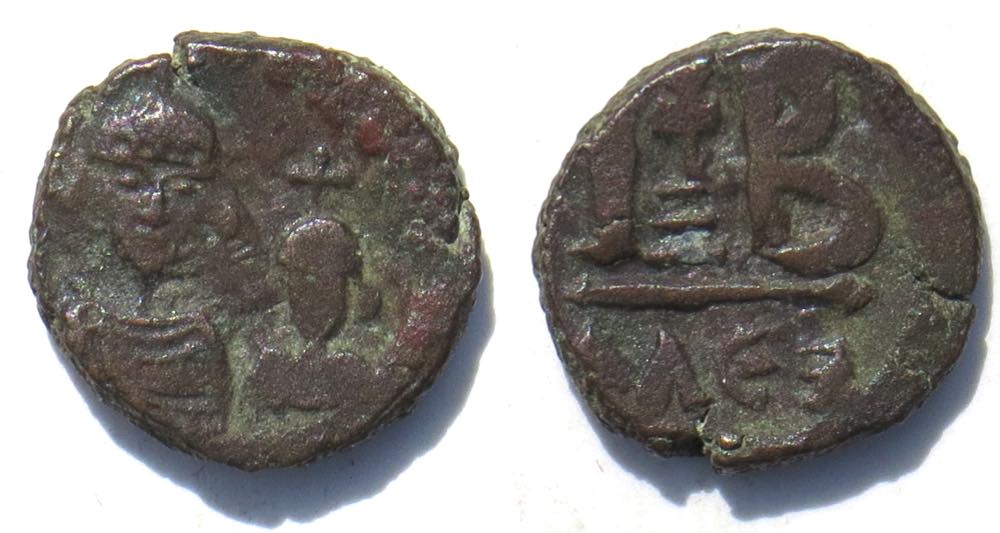
Heraclius, 610-641.
17 mm. 5.61 grams. This type is slightly thicker than other Byzantine coins.
Heraclius and his son Heraclius Constantine.
I is 10 and B is 2 in Greek, for a total of 12. There is a cross between them.
The exergue has AΛЄΞ for Alexandria.
Sear 853.
There are, of course, scholarly theories about why Alexandria used such odd denominations, but a clear and convincing reason has not emerged.
Carthage. North Africa, including Carthage, was lost to the Byzantine empire when it was conquered by the Vandals in 439. Justinian made a point of recovering it from the Vandals and Italy from the Ostrogoths. Carthage was returned to the empire in 533/4 and its coins are scarce. It was lost for good to the Arabs in 698. Rome was returned to the empire c. 535 but lost again to the Lombards is 568 and its coins are rare.
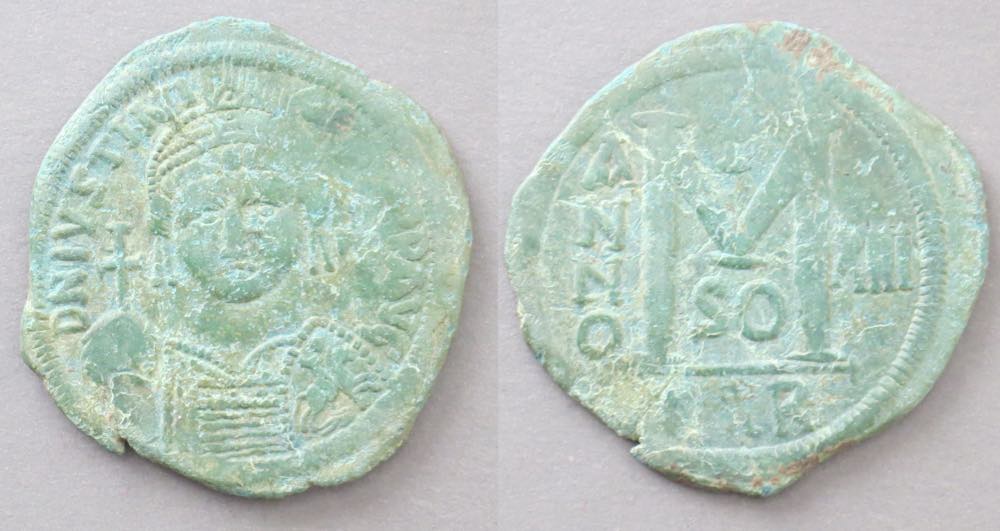
Justinian, 527-565.
41-38 mm. 20.17 grams. Follis.
Very large. [Not to scale; It is too large!]
Large M (for 40). ANNO XIII (year 13).
SO below the M (Sola Officina?)
KAR (the K is weak) in exergue.
Sear 260.
The coin reform which began in year 12 at Constantinople reached Carthage in year 13.
Unlike other mints at this time, Carthage struck a 1-nummus piece.

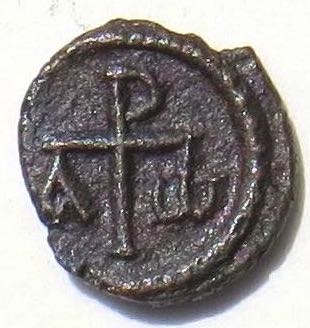
Justinian, 527-565.
9 mm. 0.55 grams. 1-nummus.
facing bust
Reverse enlarged: Cross-rho with alpha (A) and omega (ω) hanging from the ends.
Sear 342
Syracuse. When Italy was reconquered for the empire, Syracuse, on the southeast coast of Sicily, became a Roman mint. Under Heraclius it overstruck many earlier coins with small dies depicting Heraclius on the obverse and SCL for Sicily on the reverse.
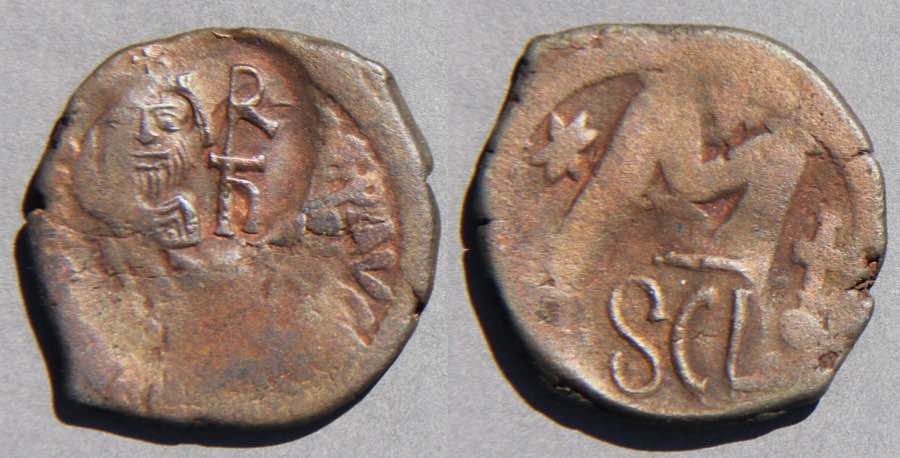 Heraclius, 610-641, overstruck at Syracuse on a follis of Justinian from before the reform of Justinian in 538. (So, the coin was at least 72 years old when it was restruck.)
Heraclius, 610-641, overstruck at Syracuse on a follis of Justinian from before the reform of Justinian in 538. (So, the coin was at least 72 years old when it was restruck.)
His bust with a monogram for Heraclius to the right.
SCL with a bar above, abbreviating Sicily.
34-31 mm. 15.70 grams (which is the size of the undertype)
Sear 882 over Sear 161.
Syracuse also struck coins with full-flan dies, but almost all are overstruck on previous coins, as opposed to struck on newly-prepared blank flans.
Cherson. Cherson is a city in Crimea, a peninsula into the north of the Black Sea. It was a distant outpost in a region that provided wheat to Constantinople. Its coinage was often quite different from elsewhere. At about the time of Maurice (582-602) it issued the follis that usually had an M for 40 with an H for 8, reckoning in units of 5. (8x5 = 40.)
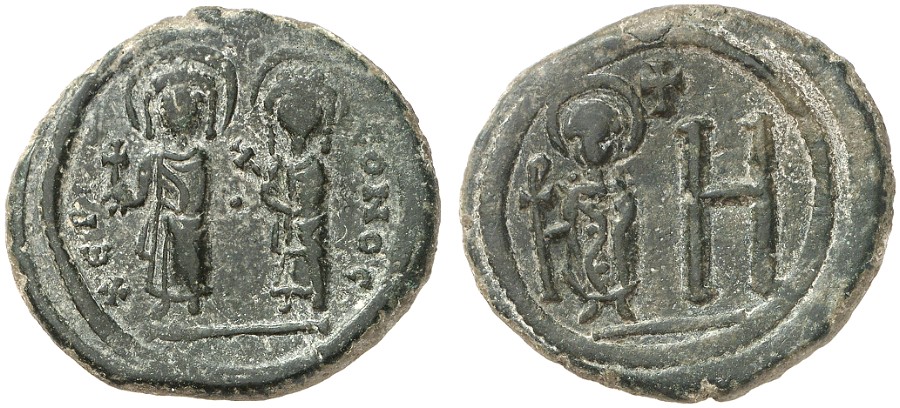 An anonymous follis of Cherson, with legend
An anonymous follis of Cherson, with legendAlthough coins of Cherson are scarce or rare, they are available and could form a collection. See my website on coins of Byzantine Cherson here. Once again, you can decide to collect anything you like, even if no one else would think of it.
There are other mints discussed on page 2 and a page on rarer mints.
Overstrikes. Many Byzantine copper coins are not struck on newly prepared blank flans, rather they are stuck on older coins. Mint work was often so sloppy that the undertype is often not fully erased and still has enough visible to be identified. Then we can infer that the undertype was issued before the overtype. If the relative chronology of types is uncertain, overstrikes can sometimes be used to put them in order. This is how the "anonymous folles" were put in order.
 The obverse of this type of Constantine X (1059-1067) has a standing figure of Christ. The poor strike did not obliterate the 3-line legend of the undertype (see lettering across the field slanted from 8:30 to 2:00), which can be identified as a Class D anonymous follis. The date of the Class D follis is not determined by the reign of an emperor because no emperor is named on "anonymous folles." But we can use this overstrike to determine that Class D was struck at the latest at the time of Constantine X.
The obverse of this type of Constantine X (1059-1067) has a standing figure of Christ. The poor strike did not obliterate the 3-line legend of the undertype (see lettering across the field slanted from 8:30 to 2:00), which can be identified as a Class D anonymous follis. The date of the Class D follis is not determined by the reign of an emperor because no emperor is named on "anonymous folles." But we can use this overstrike to determine that Class D was struck at the latest at the time of Constantine X.
31-26 mm. 8.80 grams.
Sear 1853 over Sear 1836.
Most collectors want well-struck examples of the types. But Byzantine collectors can enjoy and learn from overstrikes (which otherwise look pretty bad) if the undertype is identifiable. Overstruck coins are common and interesting.
Terms. Glossary. Here are a few terms used in the descriptions of Byzantine coins.
Billon, a term for an alloy which is primarily base metal (copper, maybe with some lead) and which has a small, but significant, amount of silver, usually not enough silver to make it look silvery, but enough to affect the metal value because silver worth 80 times as much as copper by weight.
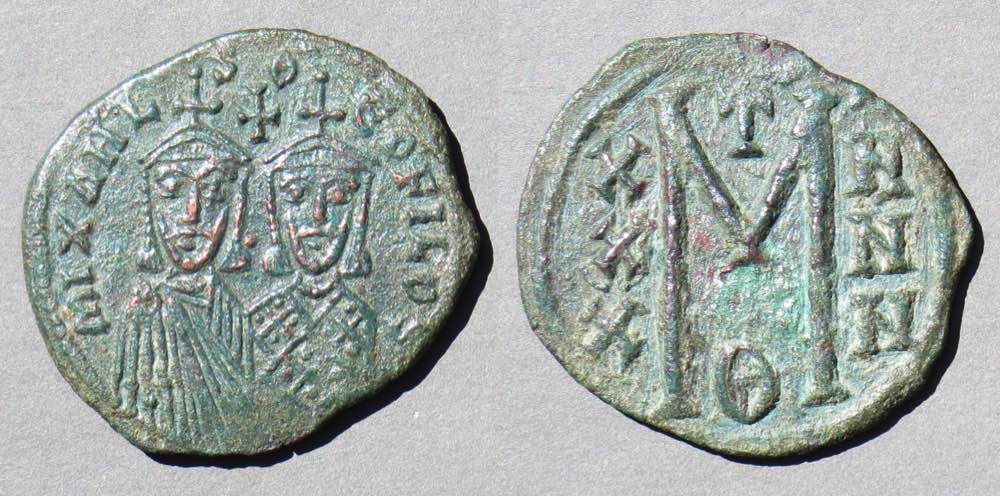 Chlamys, full-length purple imperial cloak that was the most important indication of the right to rule, as on Michael II (820-829) on the left on this coin (Sear 1642, 31-28 mm. 7.96 grams) with Theophilus (from 821) wearing loros on the right.
Chlamys, full-length purple imperial cloak that was the most important indication of the right to rule, as on Michael II (820-829) on the left on this coin (Sear 1642, 31-28 mm. 7.96 grams) with Theophilus (from 821) wearing loros on the right.
Electrum, the term for a mixture of gold and silver where there is enough silver that it is evident it is not pure gold. Byzantine gold coins were nearly pure gold for hundreds of years, but late in the 11th century the gold becomes "pale" from the large amount of silver in the alloy.
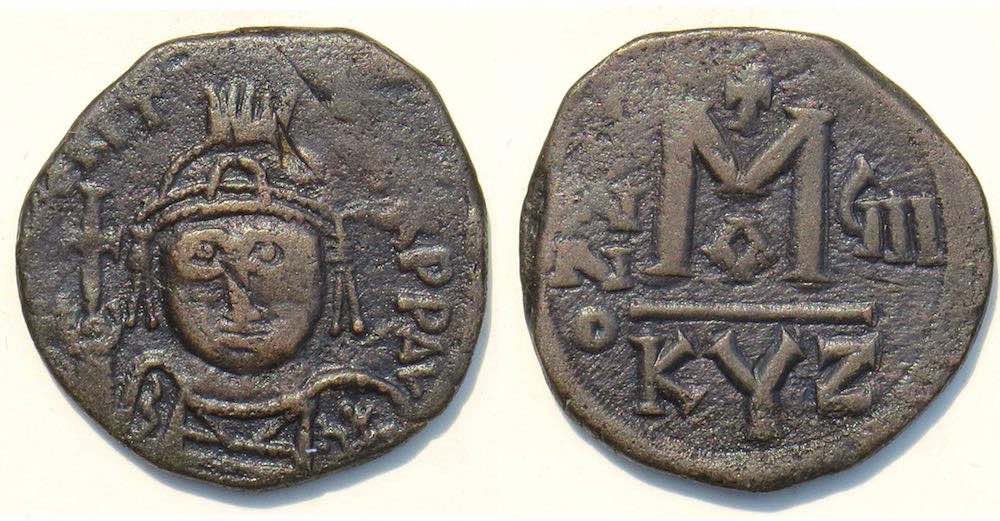
Exergue = the part of the reverse at the bottom below the horizontal line. It is often the location of a mintmark. This coin of Maurice (582-602) at Cyzicus has "KYZ" in exergue. (30 mm. 12.68 grams. Sear 518. Year GII = 8, 589/590. Cyzicus had some remarkably poor portraits.)
Loros (a type of clothing. See the image above under Chlamys.)
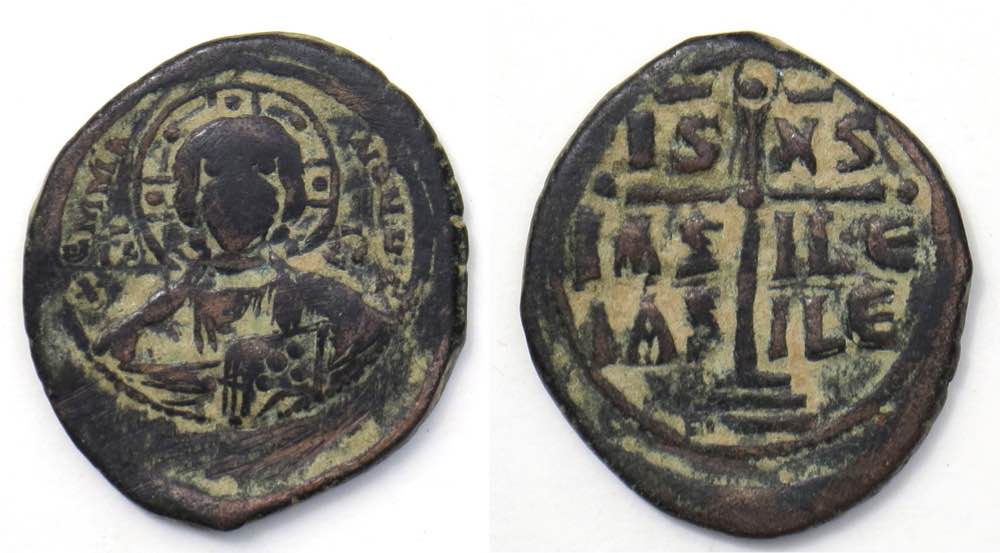
Nimbus, nimbate = halo, with halo. The circle around the head of Christ is sometimes divided by three bands with some small decoration in each. On this "Class B" anonymous follis of c.1028-1042 the decoration is a single dot. (30-27 mm. 11.03 grams. Sear 1813.)
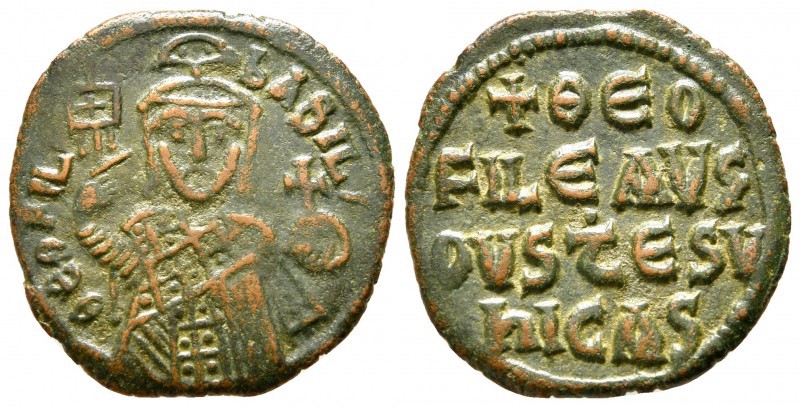
Globus cruciger = a globe with a cross on it. It fits in the hand. This half-follis of Theophius (829-842) has a globus cruciger in his left hand (on our right) and a labarum in his right hand. (23-22 mm. 3.89 grams. Sear 1668.)
Labarum = a long staff with a banner at the top, often with a Christian symbol.

Mappa = a roll of cloth thrown down to begin the games. This example shows a mappa in the emperor's right hand and an eagle-tipped scepter in his left. (Tiberius II, 578-582. Year 5. 36-34 mm. 17.43 grams. A very big coin. Sear 430.)
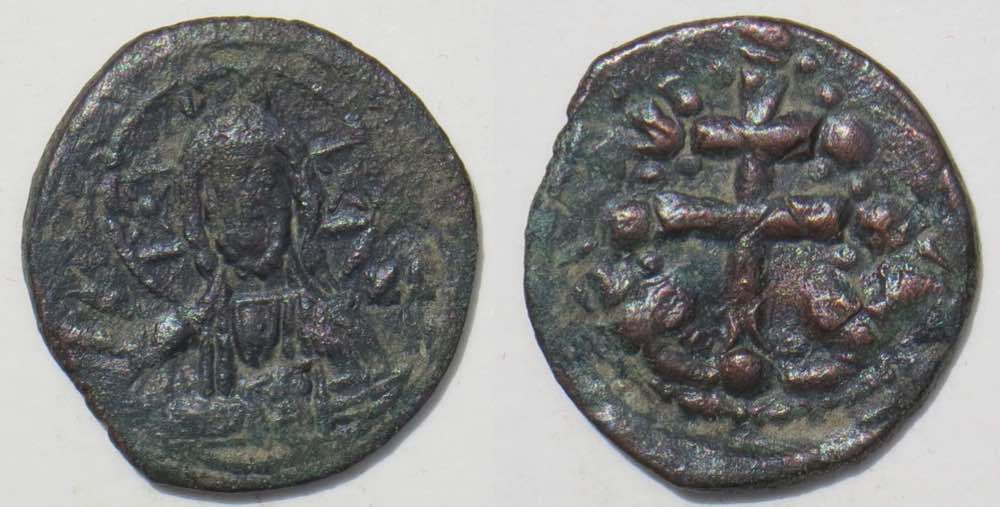
Patriarchal cross = a cross with two crossbars.
The reverse of this anonymous follis of "Class H" (1071-1078) has a patriarchal cross. (23 mm. 4.45 grams. Sear 1880)
Trachy = a (slightly) cup-shaped coin (see above).
Continue with page 2 on "Byzantine-Coin Letters, Numerals, Denominations, and Dates"
Page 3: Byzantine Emperors on Coins, AD 491-c.1118. The story of Basil I, Constantine VII,
Page 4: "Late Byzantine AE, 1059-1204" (Constantine X to the fall of Constantinople to the crusaders).
Page 5: "Byzantine Coins, 1204-1453."
Page 6: "Legends on Byzantine coins. How to read Byzantine coins."
Here is the story of an overstrike of Constantine VII on Romanus I.
Here is the story of the earthquakes at Antioch and its coins of Justinian.
A short page on the empress Irene (780-802).
Here is a page on "Byzantine 'anonymous folles' of the 10th and 11th centuries."
Go to the page (page 7) on reference works on Byzantine coins.
To learn more you can surf the web or get a book on Byzantine coins. I offer some recommendations here.
Return to the top of this page.
Go to the Table of Contents of this whole educational site.